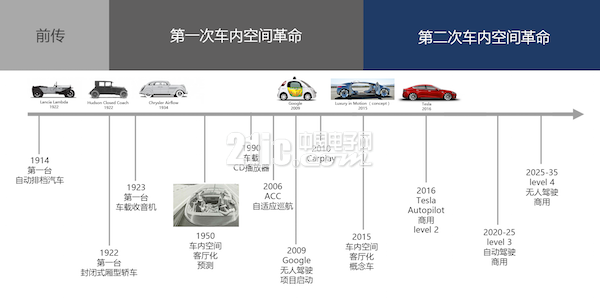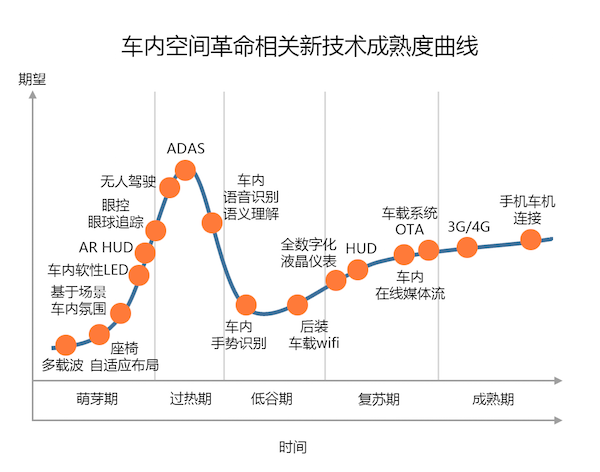What can we do when the car is more than just a car?
This article refers to the address: http://
In 1922, Hudson Company of the United States launched a closed-type sedan. As the market share exceeded that of the convertible sedan, the interior space of the car completed the first subversive change from open to closed, becoming the successor and office. Three living spaces.
In the past 100 years, although the car has made rapid progress in shape, power, materials, etc., there has not been any substantial change in the behavior of people in the interior space. A typical example is car radio, the most high-frequency application in the car scene, and the current broadcast experience is nothing new compared to the first Motorola car broadcast in 1923.
Today, there is a consensus on the upstream and downstream of the automotive vertical chain. The evolution of the interior space has reached a critical point. The second interior space revolution has been opened and will fully penetrate into our lives in the next 5-10 years. in. In contrast to the explosive growth of mobile phones from function machines to smart phones, this disruption will bring us new scenes and new experiences like never before. The expansion of in-car scenes means huge opportunities for entrepreneurs.

This article aims to share with you the future of passenger car interior space, new scenarios and the core technology applications behind these scenarios. We believe that only by seeing the trend is it possible to find a place before the wave. There is also a huge imagination in the front of the car and other commercial models, but it is not discussed in this article.
New indicator
Li wants to name his new company as a car and home. The meaning is self-evident, and the interior space will eventually become a seamless extension of our living space. What indicators will we see in the next 20 years?

1. In-car interaction design takes priority from safety priority to efficiency experience
The evolution of the interior space is strongly related to the evolution of the car's self-driving ability, which is why in the past 100 years we have been able to do a very single thing in the car, that is to concentrate on driving. Based on the safety priority philosophy, the in-vehicle interactive HMI, in-vehicle equipment and applications have always been in the process of forming rules for a hundred years. The host factory's offering of physical button gods is the best example.
Today, as the driving safety is decoupled from the driver and gradually handed over to the car itself, the foundation of the safety priority philosophy has been loosened. When the car's self-driving ability enters the level 3 - 4 level, the in-vehicle interaction design HMI will completely abandon the existing philosophy. Security priorities are replaced by efficiency/experience priorities.

Left: Car radio in 1952; Right: Tesla center console 2. Interior space in the car
The commercialization of Level 4 fully unmanned technology will not only revolutionize the urban transportation system, but will also create disruptive changes in the interior of the car. The driver's self-driving ability will gradually liberate the driver's hands, vision and hearing. When the automatic driving needs to exit in the special situation that cannot be handled, the driver has about 15-20 seconds of reaction time to re-enter the driving state.
This new mode of operation will blur the boundaries between the driver and the passenger, and also bring a new layout to the interior of the car. The Mercedes-Benz F015 concept model has demonstrated a flexible seat layout system. The front-to-back layout of the front and rear seats will make the interior space of the car, while the living room means that more applications in the living room may be translated into the car. .

Left: The 1950's Saturday Post's prediction of the interior space; Right: 2015 Mercedes Concept Car 3. Shared Space
The gradual evolution of cars from personal accessories to socialized public travel tools is a general trend. However, although Didi and Uber have fully popularized the concept of “sharing economy†in the past few years, the external form and interior design of the car still proceed from the needs of personal transportation, which leads to serious use scenarios and forms. Does not match. We believe that the new form of interior space designed to serve the concept of “sharing†will soon emerge, and new models that are truly adapted to the use scenarios of network-based vehicles, time-sharing, and commuter traffic will gradually be available.
The new form of interior space will be multi-modal, with memory and variable space that can be quickly adapted. It satisfies individual space requirements while enabling fast switching between different scenes and different individuals. It is conceivable that, based on the individual identity of each person, the interior space can quickly and automatically adjust the seat layout, the mirror angle, the interior temperature, the driving mode and even the body color.
4. Mobile computing space
In the next 5-10 years, full-time, high-speed, stable cloud connectivity will become one of the basic configurations of the car. Driverless cars produce 1G of data per second, and the scale of such data collection will greatly increase the requirements for the car's own data processing capabilities. At the same time, tasks such as massive data storage, computational analysis, and so on are done in real time or asynchronously in the cloud. For the passengers in the car, with the evolution of the living space in the car, more entertainment, work scenes will also be translated into the car, personal computing needs also put forward new requirements for the future car space.
new technology
The joint effort to open the second interior space revolution was driven by a series of new technology growth. The chart below depicts the growth curve of new technologies related to the interior space revolution in the past five years.

Always online
Cloud connectivity will become the standard for new cars in 5-10 years. Users won't buy a car without connectivity. It's like not buying a laptop without a wifi module. As the cost of network traffic gradually declines, inter-city roaming charges are gradually phased out, and cars will always be online like today's smartphones. Based on this judgment, those who have the ability to provide high-quality in-vehicle network infrastructure, technical solutions and post-traffic operation services will be the partners that the OEMs are looking for.
Based on the demand for high-speed stable networks, how to apply the multi-carrier technology in the budding period in the car is especially worthy of attention. Multi-carrier network technology is used to provide a continuously stable network at high speeds. Simply put, it can aggregate multiple carriers into a wider spectrum, and also can aggregate some discontinuous spectrum fragments together, which can well meet the spectrum compatibility requirements of LTE and LTE-Advanced systems.
The application of 4G network in the car has entered a mature stage, and a large number of OEMs are about to launch or have already launched pre-installation solutions (such as Roewe RX5). At the same time, the owners in the stock market have gradually recognized the necessity of car online, car wifi In the aftermarket, it is on the eve of recovery. The penetration of the network infrastructure in the car will further promote the on-board system OTA and in-car online media streaming technology to mature.
ECG Trunk Cable,ECG Wire,ECG Patient Cable,ECG Lead Wire
Dong guan Sum Wai Electronic Co,. Ltd. , https://www.sw-cables.com